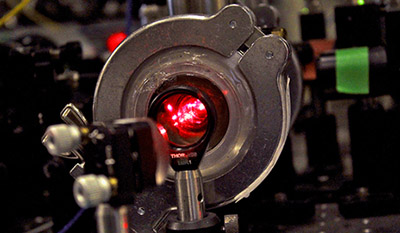Cool molecules are hot item
21st August 2014
USA: Physicists at Yale University claim to have achieved the coldest ever molecules through direct cooling.
The molecules in question are bits of strontium monofluoride (SrF), dropped to 2.5 thousandths of a degree above absolute zero. This was achieved through a laser cooling and isolating process called magneto-optical trapping (MOT).
Said to be the coldest molecules ever achieved through direct cooling, the achievement is described as a “physics milestone” likely to prompt new research in areas ranging from quantum chemistry to tests of the most basic theories in particle physics.
“We can start studying chemical reactions that are happening at very near to absolute zero,” said Dave DeMille, a Yale physics professor and principal investigator. “We have a chance to learn about fundamental chemical mechanisms.”
Magneto-optical trapping has become commonly used by atomic physicists — but only at the single-atom level. The technology uses lasers to simultaneously cool particles and hold them in place.
“Imagine having a shallow bowl with a little molasses in it,” explains Dave DeMille. “If you roll some balls into the bowl, they will slow down and accumulate at the bottom. For our experiment, the molecules are like the balls and the bowl with molasses is created via laser beams and magnetic fields.”
DeMille and his colleagues built their own apparatus in a basement lab. It is an elaborate, multi-level tangle of wires, computers, electrical components, tabletop mirrors, and a cryogenic refrigeration unit. The process uses a dozen lasers, each with a wavelength controlled to the ninth decimal point.
It works this way: Pulses of strontium monofluoride shoot out from a cryogenic chamber to form a beam of molecules, which is slowed by pushing on it with a laser. “It’s like trying to slow down a bowling ball with ping pong balls,” DeMille explained. “You have to do it fast and do it a lot of times.” The slowed molecules enter a specially-shaped magnetic field, where opposing laser beams pass through the center of the field, along three perpendicular axes. This is where the molecules become trapped.
“Quantum mechanics allows us to both cool things down and apply force that leaves the molecules levitating in an almost perfect vacuum.”







